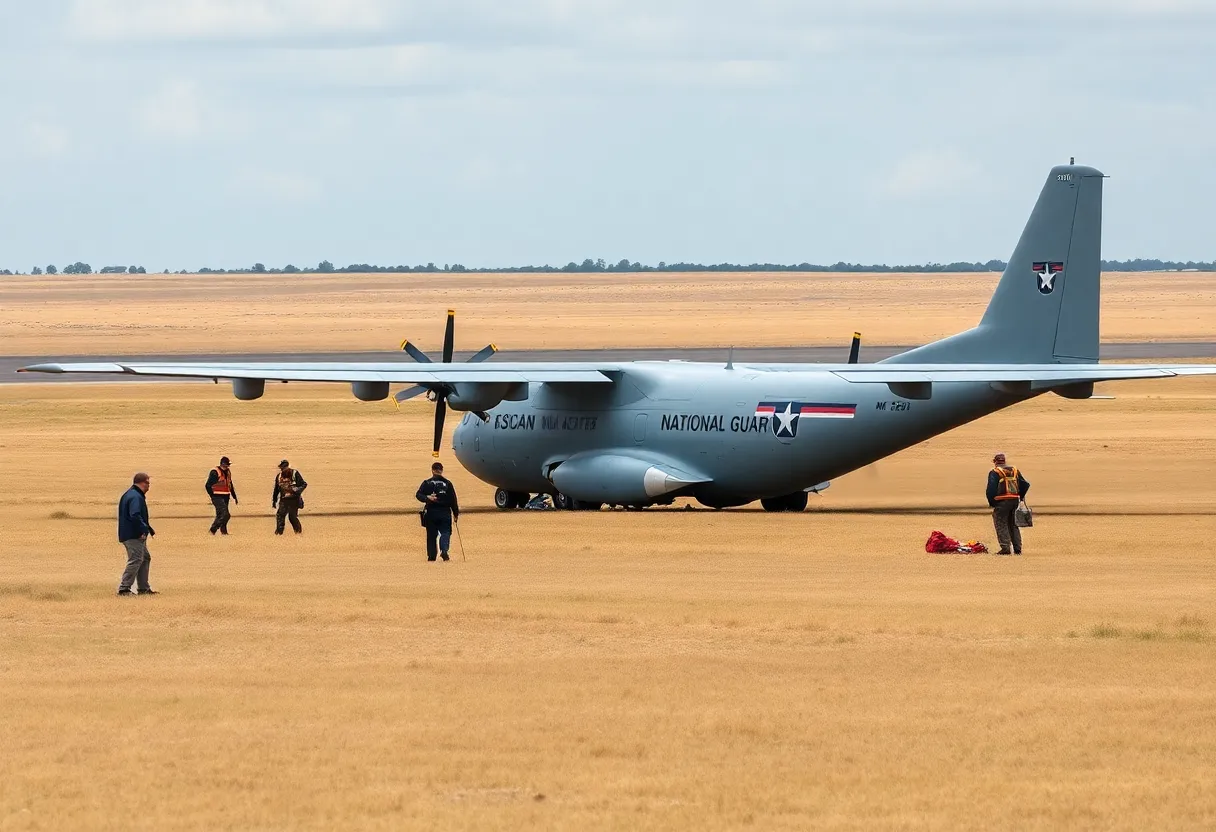Oklahoma City, October 25, 2025
A National Guard aircraft performed an emergency belly landing in a vacant field near Interstate 240 in southeast Oklahoma City after experiencing a mechanical issue mid-flight. All four crew members were unharmed and received minor medical evaluations. The OKC Fire Department promptly contained a fuel leak and secured the scene with no disruptions to traffic reported. Federal investigators are currently examining the incident to determine the cause of the mechanical failure.
Emergency Landing of National Guard Aircraft in Southeast Oklahoma City
Oklahoma City – A National Guard aircraft executed an emergency belly landing in a vacant field near Interstate 240 in southeast Oklahoma City on Thursday evening, with all four crew members emerging unharmed after minor medical evaluations.
The incident occurred around 8:00 p.m. when the aircraft encountered a mid-flight mechanical issue, prompting the crew to safely bring the plane down in an open area off I-240. First responders from the OKC Fire Department arrived promptly to secure the scene, confirming the aircraft’s controlled descent via belly landing, which avoided a more catastrophic crash. The crew, consisting of four personnel, underwent on-site medical checks for minor concerns but required no further treatment, allowing them to be released shortly after.
Response and Containment Efforts
Upon arrival, fire department teams addressed an immediate concern of fuel leakage from the aircraft. Crews worked swiftly to contain the spill, preventing any environmental hazards or risks to nearby traffic on I-240. The area was cordoned off to ensure public safety, with no disruptions reported to the highway despite the proximity. Federal investigators have since arrived at the site to examine the aircraft and determine the exact cause of the mid-flight problem, which initial reports suggest involved a mechanical failure during routine operations.
The belly landing technique, where the aircraft touches down without deploying its landing gear, is a standard emergency procedure designed to minimize damage and protect the crew. In this case, it proved effective, as the plane remained largely intact in the field, away from populated areas or infrastructure. Emergency services coordinated seamlessly, with support from local law enforcement to manage onlookers and maintain order.
Context of the Incident
The aircraft, identified as part of the Oklahoma National Guard’s fleet, was engaged in a training exercise at the time of the malfunction. Such flights are common in the region, given the proximity of Tinker Air Force Base and other military installations. This event marks a rare but notable occurrence for military aviation in the Oklahoma City area, underscoring the preparedness of local emergency responders.
Historical data on similar incidents shows that belly landings often result in successful outcomes when executed properly, with crew safety prioritized. Past events in the state have involved everything from small propeller planes to larger jets, but none in recent years have escalated to major casualties due to rapid response times. The OKC Fire Department‘s involvement highlights their role in handling both civilian and military emergencies, a responsibility they fulfill through ongoing training and equipment readiness.
Broader Implications for Aviation Safety
While the incident did not result in injuries or widespread disruption, it serves as a reminder of the inherent risks in military aviation operations. The prompt containment of the fuel leak prevented potential fire hazards, demonstrating effective protocols in place for such scenarios. As investigators delve deeper, updates are expected on the mechanical issue, which could lead to procedural adjustments for National Guard flights in the future.
Local authorities have assured residents that there is no ongoing threat, and the site will remain under investigation until cleared. This event, occurring amidst otherwise routine activities in southeast Oklahoma City, reflects the community’s resilience and the coordinated efforts of public safety agencies. Further details from the federal probe may shed light on preventive measures, ensuring similar operations continue safely.
The Oklahoma City metropolitan area, home to numerous military assets, routinely supports such training missions without incident. This safe resolution reinforces confidence in the systems designed to protect both aircrews and the public below.
FAQ
What happened in the National Guard plane crash in Oklahoma City?
A National Guard aircraft executed an emergency belly landing in a vacant field near Interstate 240 in southeast Oklahoma City after encountering a mid-flight mechanical issue.
Were there any injuries from the incident?
The crew of four received minor medical checks but no serious injuries, and they were released shortly after the event.
How did emergency services respond to the crash?
The OKC Fire Department arrived promptly, contained fuel leaks from the aircraft, and secured the scene to prevent any hazards.
What is the current status of the investigation?
Federal investigators are on scene to probe the mid-flight issue that led to the emergency landing.
Was there any impact on nearby areas like I-240?
No disruptions were reported to traffic on I-240, as the landing occurred in a vacant field off the highway.
Key Features Chart
The following table outlines the key aspects of the National Guard aircraft emergency landing in Oklahoma City.
| Aspect | Details |
|---|---|
| Location | Vacant field off I-240 in southeast Oklahoma City |
| Type of Incident | Emergency belly landing due to mid-flight mechanical issue |
| Crew Status | Four crew members; minor checks, no serious injuries |
| Emergency Response | OKC Fire Department contained fuel leaks quickly |
| Investigation | Federal investigators on scene probing the issue |
| Impact | No injuries, no traffic disruptions |
Deeper Dive: News & Info About This Topic
HERE Resources
Dramatic Emergency Landing of National Guard Plane in Oklahoma City





